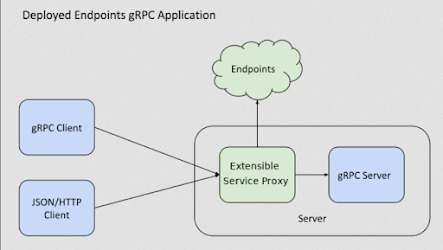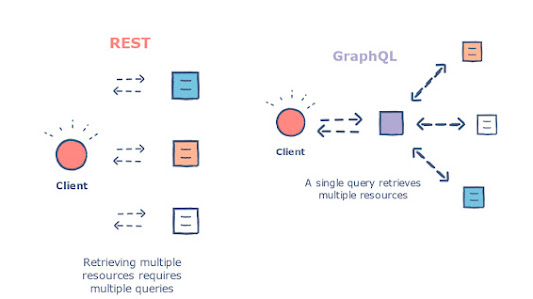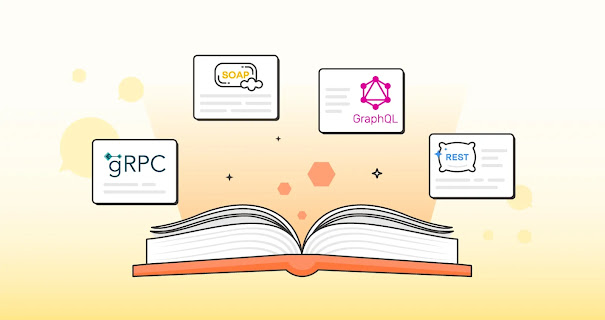There is no doubt that today's word is about API. No matter what kind of application you are working it involves API whether its internal API to get data from another system or external API like Paypal and Stripe API for payments, but how do you incorporate APIS in your system. In the vast landscape of API technologies, there are four prominent contenders that stand out: gRPC, REST, SOAP, and GraphQL. Each of them offers a unique approach to building and consuming APIs, presenting developers with a plethora of choices. In this article, we will delve into the distinctive characteristics of gRPC, REST, SOAP, and GraphQL, unraveling their differences and helping you navigate the API universe with confidence.
What is gRPC, REST, SOAP, and GraphQL?
Now let's deep dive into each of these 4 technologies to learn them in more details so that not only you can use them in your application with confidence but also answer any question on interviews relative to that.
1. gRPC: The Speedy Innovator
First on our list is gRPC, a modern and lightning-fast API framework. gRPC utilizes Protocol Buffers, a compact and efficient data serialization mechanism. It's like having a supercar that effortlessly zooms through the information highway.
With gRPC, you can enjoy the benefits of high-performance communication and automatic code generation, making it a preferred choice for scenarios that demand real-time data synchronization and low latency. If speed is your game, gRPC is here to take you on a thrilling ride.
2. REST: The Universal Communicator
Next up is REST, the tried-and-true veteran of API architectures. REST embraces the principles of simplicity, scalability, and universality. It speaks the language of the web, leveraging the power of HTTP to provide a standardized approach for data exchange.
RESTful APIs are resource-oriented, allowing you to interact with data using the familiar HTTP verbs like GET, POST, PUT, and DELETE. It's like having a reliable friend who knows how to navigate any situation, making REST a versatile and widely adopted choice for web-based systems.
Here is also a nice diagram which highlights the difference between REST and GraphQL APIs
3. SOAP: The Robust Commander
Moving forward, we encounter SOAP, an older but battle-tested protocol for building APIs. SOAP stands for Simple Object Access Protocol, although simplicity may not be its defining characteristic. SOAP relies on XML for message format and has a complex structure that incorporates features like encryption, authentication, and transaction management.
It's like a military general with a meticulously planned operation, ensuring utmost reliability and security. SOAP is suitable for enterprise-level systems that require robustness and strict adherence to standards.
4. GraphQL: The Flexible Visionary
Lastly, we encounter GraphQL, a revolutionary query language for APIs. GraphQL challenges traditional approaches by providing a flexible and client-driven model. With GraphQL, clients can request precisely the data they need, avoiding over-fetching and under-fetching problems often associated with RESTful APIs.
It's like having a personal assistant who understands your desires and fetches information accordingly. GraphQL's power lies in its introspection capabilities, enabling clients to explore the available data structures and tailor their requests accordingly.
If you seek a more efficient and tailored API experience, GraphQL is poised to be your ally.
Difference between gRPC, REST, SOAP, and GraphQL
There are several key differences between gRPC, REST, SOAP, and GraphQL:
- Data format: gRPC uses Protocol Buffers, REST and GraphQL use JSON, and SOAP uses XML.
- Efficiency: gRPC and GraphQL are designed to be very efficient, while REST and SOAP are less so.
- Flexibility: gRPC and SOAP are more rigid and less flexible, while REST and GraphQL are more flexible.
- Security: SOAP offers advanced security features, while the other technologies offer basic security features.
- Ease of use: REST is the easiest to use, followed by GraphQL, gRPC, and SOAP.
- API Style: gRPC and SOAP follow the RPC (Remote Procedure Call) API style, while REST and GraphQL follow the RESTful API style.
- Statelessness: REST and GraphQL are stateless, while gRPC and SOAP are stateful.
- Caching: REST APIs are highly cacheable, while gRPC and GraphQL APIs are not.
- Error Handling: gRPC and SOAP use structured error messages, while REST and GraphQL use HTTP status codes.
- Schema Definition: gRPC and GraphQL have schema definitions, while REST and SOAP do not.
- Support for Multiple Languages: gRPC supports multiple programming languages, while REST, SOAP, and GraphQL are limited to specific programming languages
- Versioning: REST and SOAP support versioning of APIs, while gRPC and GraphQL do not have built-in support for versioning. However, versioning can still be achieved in gRPC and GraphQL by creating multiple services or types, or by adding versioning information to the API endpoints.
- Security: SOAP and REST both support SSL (Secure Sockets Layer) and HTTPS (Hypertext Transfer Protocol Secure) for secure communication, while gRPC and GraphQL have their own security mechanisms. gRPC provides authentication and encryption using SSL, and also allows for the use of custom authentication mechanisms. GraphQL supports authentication and authorization through middleware.
- Tools and Frameworks: REST and SOAP have a wider range of tools and frameworks available for development and testing, while gRPC and GraphQL are relatively new and have fewer tools and frameworks available. However, the popularity of gRPC and GraphQL is growing, and more tools and frameworks are being developed to support these technologies.
- API Documentation: REST and GraphQL are known for their clear and comprehensive documentation, while SOAP and gRPC documentation can be more difficult to navigate. This is partly due to the fact that SOAP and gRPC are more complex technologies with more options and features.
In terms of scalability, gRPC is known for its ability to handle large amounts of data and high traffic loads. This is due to its efficient binary data encoding and support for streaming. GraphQL also has good scalability due to its ability to request only the data needed, which reduces server load. REST and SOAP can also be scaled, but they may require more resources and additional configurations.
In terms of performance, gRPC and GraphQL are considered to be faster and more efficient than REST and SOAP. gRPC uses binary data encoding, which reduces the size of data transferred over the network. It also offers streaming, which means data can be sent as a stream of messages rather than as a single request-response cycle.
Similarly, GraphQL allows clients to request only the data they need, which reduces over-fetching and under-fetching of data.
On the other hand, REST and SOAP have wider adoption and are more widely understood. They are also easier to use and implement. REST APIs can be consumed by any client that supports HTTP, while SOAP APIs can be consumed by any client that supports XML. This means that they are more flexible and can be used in a wider variety of projects.
In conclusion, choosing the right API technology depends on the specific needs of the project. While gRPC and GraphQL may be better for projects that require high performance and efficiency, REST and SOAP may be more suitable for projects that require ease of use and wider adoption. It is important to consider factors such as the data format, efficiency, flexibility, security, ease of use, and other specific requirements when choosing an API technology.
Conclusion
In conclusion, gRPC, REST, SOAP, and GraphQL are all useful technologies for building APIs. Each technology has its own strengths and weaknesses, and developers should choose the technology that best fits their needs. If efficiency and performance are paramount, gRPC or GraphQL may be the best choice. If simplicity and ease of use are important, REST may be the best choice. If advanced security features are needed, SOAP may be the best choice. Ultimately, the choice between these technologies will depend on the specific requirements of the project and the needs of the users.





No comments:
Post a Comment